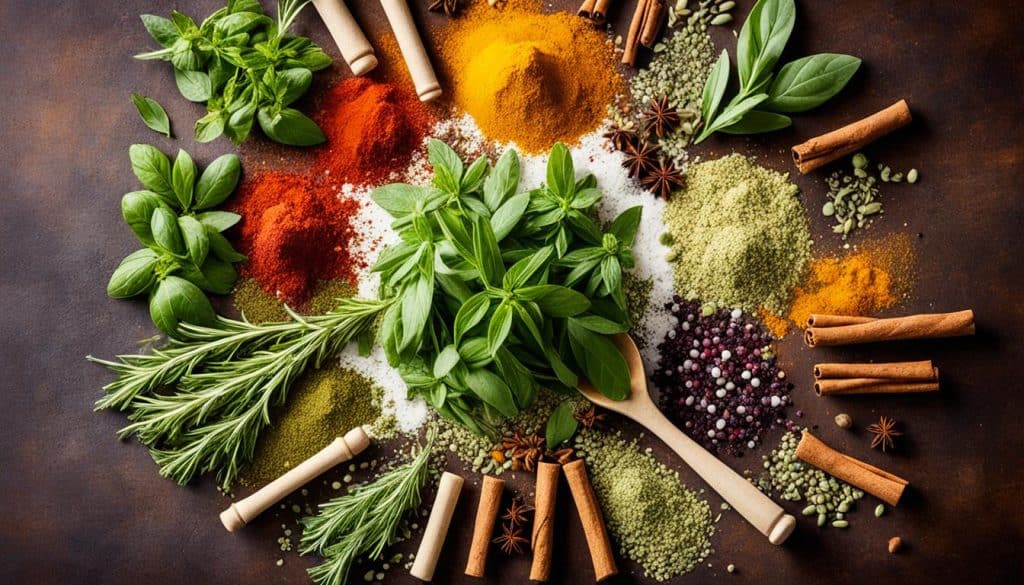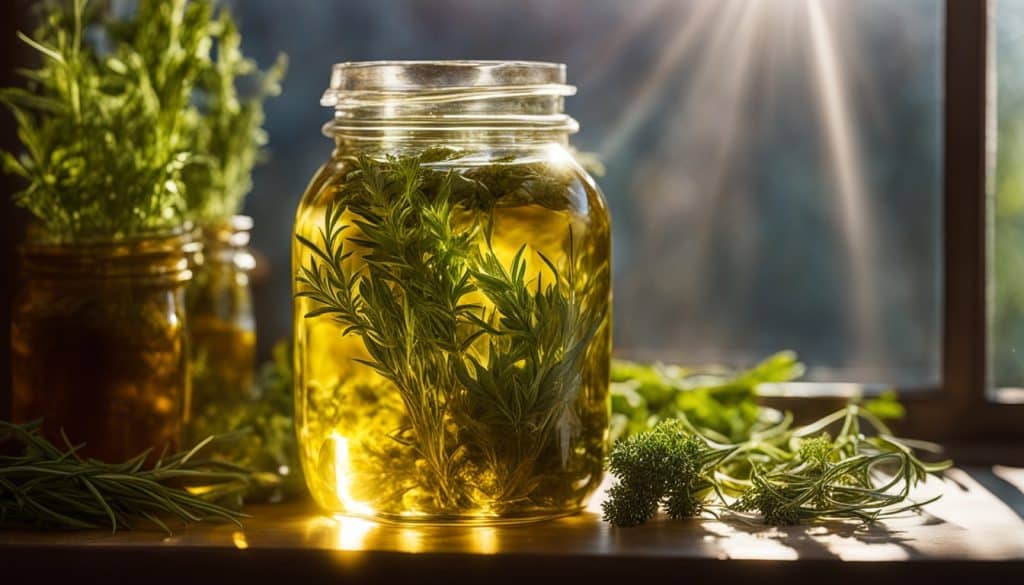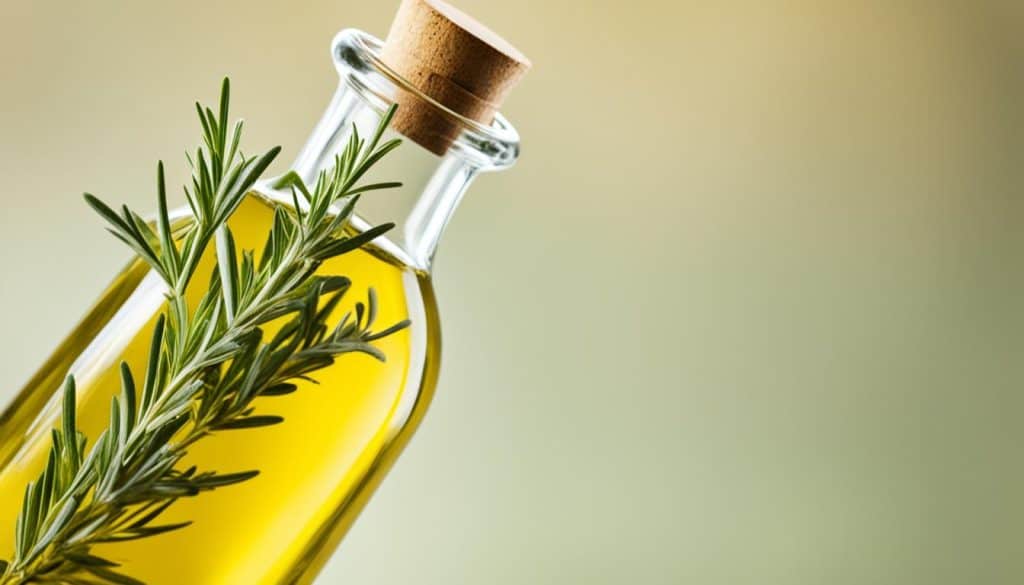Imagine the scent of warm, freshly baked bread filling your kitchen. It brings cozy comfort to your home. Now, imagine that same loaf with the flavors of rosemary, thyme, and basil. These herbs add an aromatic richness that takes your baking to new heights.
Fresh herbs are a secret weapon in making delicious pastries, breads, and desserts. They have the power to turn your baked goods into culinary masterpieces. This adds both taste and beauty to your creations.
Rosemary is a fragrant herb with a distinct woody taste. It’s great in many baked goods, like bread, biscuits, quiches, and tarts. Just a sprinkle of rosemary adds a savory element that goes well with sweet and savory dishes.
Thyme has an earthy and slightly minty flavor. It’s perfect with buttery shortbread cookies. Basil is another versatile herb that adds a fresh taste to cakes, cupcakes, ice cream, and focaccia bread.
Key Takeaways:
- Infusing fresh herbs into your baked goods can elevate their flavors and add aromatic richness.
- Rosemary, thyme, and basil are just a few examples of herbs that can enhance your baking.
- Experiment with different herbs to discover exciting flavor combinations in your favorite recipes.
- Fresh herbs provide a burst of flavor, nutrients, and antioxidants, making them a popular choice among chefs.
- Explore herb-food pairing guides to learn more about suitable combinations and cooking tips.
The Art of Spice-Tempering
Spice-tempering is a centuries-old technique used in Indian cooking. It brings depth and complexity to dishes by bringing out the best in spices. This method, also known as tadka, involves heating oil or ghee with spices. This creates a rich, fragrant base for cooking.
Getting the details right is crucial in spice-tempering. The right mix of oil and spices, along with careful temperature control, can make your dishes taste amazing.
The Power of Spice-Tempering
Spice-tempering starts by heating a bit of oil or ghee in a pan. Then, you add spices like mustard seeds, cumin seeds, and curry leaves. When the spices crackle and change color, it means they’re done. This method lets the spices’ flavors and aromas shine, making your dish taste better.
Tips for a Perfect Spice-Tempering
Getting good at spice-tempering takes practice and focus. Here are some tips to help you:
- Make sure your oil is hot before adding spices. Check by looking for a shimmer or by dropping in a few seeds.
- Focus on tempering without distractions. Distractions can make your spices burn and ruin the flavor.
- Choose the right oil or fat for tempering. Canola, sunflower oil, vegetable oil, or ghee work well because they don’t burn easily.
- Try different spice combinations to find what you like best. Each region in India has its own way of doing it.
- Avoid using olive oil for tempering because it breaks down at high heat and can change the taste.
- Add spices quickly one after the other. This lets each spice bloom and release its flavor.
- If you burn your spices, throw them away and start over. Burnt spices can make your dish taste bitter.

Exploring Indian cuisine, I learned how versatile spice-tempering is. You can mix traditional spices with international flavors to create something new. Adding herbs like rosemary or lemongrass can surprise your taste buds.
Why not start a spice-tempering journey and discover new flavors in your cooking? Whether you’re baking or exploring flavors, spice-tempering can elevate your dishes.
Infusing Oils for Aromatic Baking
Infusing oils with herbs is a great way to make your baking more exciting. You can use herbs like rosemary, thyme, and basil to create unique flavors. These oils are perfect for homemade salad dressings, marinades, or adding a special touch to baked goods.
There are many oils you can infuse, not just olive oil. Try using sesame, macadamia nut, sunflower seed, or avocado oil too. Each oil brings its own special taste, so feel free to experiment and find what you like best.

Methods for Infusing Oils
There are several ways to infuse oils with herbs, each with its own benefits. Let’s look at three popular methods:
- Folk (Simplers) Method: This method uses the sun to infuse oils with herbs over 2 to 3 weeks. It keeps the natural oils and flavors, making a beautiful infused oil.
- Quick Method for Heat-Infused Oils: If you’re in a hurry, this method is for you. Heat the herbs and oil gently for 1 to 5 hours. This way, you get the flavors fast without losing quality.
- Alcohol Intermediary Method for Topical Herbal Oils: This method uses alcohol to help infuse oils. Soak herbs in alcohol for a day, then add them to the oil. This makes the oil safer and more potent.
Each method has its own way of doing things. Make sure to follow the blog post’s instructions for the best results.
Quality Ingredients for Superior Infusions
For the best flavors, use high-quality herbs and oils. You can dry your own herbs or buy them from trusted suppliers like Mountain Rose Herbs. They focus on quality and being eco-friendly.
When picking carrier oils, think about their shelf life and flavor. Coconut oil and olive oil are good choices because they last a long time and let the herbs’ flavors stand out.
Tips for Successful Infusions
Infusing oils with herbs is fun and rewarding. Here are some tips to make your infusions even better:
- Always clean your glass bottles by boiling them for 10 minutes before filling them with your oils.
- Keep your infused oils in a cool, dark place to keep them fresh longer.
- Use homemade oils within two months for the best flavor.
- Follow the recipe’s instructions carefully for safe and consistent results.
With these tips, you’re ready to make delicious and aromatic infusions. Next, we’ll show you how to use these oils in your baking. Stay tuned!
Measuring Herbs for Infusions
Infusing oils with herbs doesn’t require strict measurements. Unlike baking, where precision is crucial, infusions let you experiment and personalize. You can use any jar size and adjust the herbs to get the flavor you want.
Start by using one herb at a time to learn its strength and flavor. Once you’re familiar with each herb, mix different ones for unique tastes.
Rosemary and thyme are a great pair for infusions. Their aromas and flavors work well together, making a delicious blend that enhances your dishes.
Use teaspoons or tablespoons for small infusions and cups or ounces for larger ones. The important thing is to find a herb ratio you like. Adding more herbs means a stronger flavor.
Herbs are versatile and let you customize your recipes. So, experiment, and let your taste guide you on this tasty journey.
Choosing the Right Oil for Infusions
Choosing the right oil for infusing herbs in baking is key to great flavor and aroma. Olive oil is a top pick for many because it’s neutral yet fruity. This lets the herbs’ flavors stand out, making your baked goods taste special.
But don’t just stick to olive oil. Try other oils like sesame, macadamia nut, sunflower seed, or avocado for unique tastes. These oils add their own special flavors to your baked goods, making them more interesting.
Think about the herbs and spices you’re using and how they’ll mix with the oil. For example, coconut oil pairs well with spices like coriander seeds, star anise, lemongrass, and ginger. These spices balance the coconut oil’s tropical taste.
It’s crucial to store your infused oils right to keep them fresh. Keep them in a cool, dark spot or the fridge. Use them within 4-6 weeks for the best flavor and quality.

Infused oils are great for many things, like drizzling on roasted veggies or making massage oils with lavender. The oil you choose is key to the final product. So, have fun trying different oils and herbs to make your baking stand out!
Tips for Successful Infusions
For successful infusions, focus on the quality of the herbs. Choose fresh and aromatic herbs like rosemary, thyme, and basil. These herbs add great flavors and health benefits to your infusions.
How long you infuse the herbs is key. Infusing for too long can make the flavor too strong. Start with a few hours and adjust as you like. This helps balance the herbal flavor with other ingredients.
Think about the herb to oil ratio too. Use about 1/3 to 1/2 jar of herbs in a carrier oil. This makes sure the herbs infuse well into the oil.
It’s important to dry herbs properly to avoid rancidity and bacteria. Dry the herbs well before using them. If you’re unsure about drying, look for certified organic dried herbs.
Also, different carrier oils have different benefits. You can use olive oil, almond oil, jojoba oil, avocado oil, sunflower oil, or coconut oil. Pick one based on the health benefits you want.
Follow these tips to make infusions that taste great and are good for you. Try different herbs and keep track of your recipes. This way, you can make infusions that fit your taste and health goals.
Incorporating Infused Oils in Baking Recipes
Now that you have your infused oils ready, it’s time to take your baking to the next level. Infused oils can change the game, adding unique flavors to your sweets. This makes your baking more delicious.
Whether you’re making breads, cakes, pastries, or cookies, using infused oils can add depth. These oils bring sophistication to your baked goods. They make your recipes more exciting for your taste buds.
Baking with infused oils opens up a world of possibilities. Here are some ideas to get you started:
1. Add Citrus Zest and Flavor
Citrus-infused olive oils, like lemon, orange, or grapefruit, are great for baking. They add bright and zesty flavors to sweet dishes. Add a teaspoon or two to your lemon bars, orange cake, or grapefruit muffins for a refreshing taste.
2. Enhance with Spices
Spice-infused olive oils can elevate your cookies and pastries. Cinnamon, cardamom, and clove are top choices for infusing oils. These spices will make your baked treats more aromatic and complex.
3. Create a Contrast with Chili Oil
For a taste experience with layers, use chili-infused olive oil with chocolate desserts. The mix of heat and sweetness will make your creations more indulgent.
4. Accentuate with Herb-Infused Oils
Herb-infused olive oils like basil, rosemary, and thyme are great with fruit desserts. They add a savory touch that balances sweetness. Try basil-infused oil on strawberry shortcake or rosemary-infused oil in apple pie for a twist.
5. Elevate Ice Cream Flavors
Infused oils aren’t just for baked goods. They can also enhance ice cream flavors. Add infused oil to your ice cream base for complex and decadent tastes. Experiment with different oils to find your favorite.
Remember, trying new things is key with infused oils. Don’t hesitate to experiment and find your perfect flavor mix. You might discover a unique taste that makes your desserts unforgettable.
So, why not try infused oils in your baking? They can take your recipes from ordinary to extraordinary. Let your taste buds lead you on a delicious journey with infused oils.
Enjoy the Flavorful Rewards
Adding herbs like rosemary, thyme, and basil to your baking makes your dishes taste better. These herbs bring depth and complexity to your food. For over 5,000 years, herbs and spices have been key in cooking, adding flavor and aroma to every bite.
Using fresh herbs in your baked goods opens up a world of taste. Basil can make your treats feel refreshing and lively. Chives add a light onion flavor and are full of nutrients like choline and vitamin C.
Cilantro not only tastes citrusy but also has health benefits. It helps the heart and urinary system and boosts brain function. Dill leaf is great for digestion and fighting infections. Black garlic is full of antioxidants, which can lower inflammation and improve memory.
Baking with herbs is more than just about taste. Chefs who grow their own herbs say their dishes taste better. Growing herbs at home saves money and lets you control the growing process. It ensures organic herbs without pesticides. Plus, fresh herbs make your garden look beautiful and add to your kitchen’s appeal.


